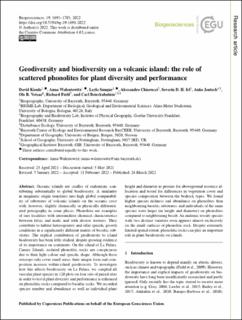| dc.contributor.author | Kienle, David | |
| dc.contributor.author | Walentowitz, Anna | |
| dc.contributor.author | Sungur, Leyla | |
| dc.contributor.author | Chiarucci, Alessandro | |
| dc.contributor.author | Irl, Severin D. H. | |
| dc.contributor.author | Jentsch, Anke | |
| dc.contributor.author | Vetaas, Ole Reidar | |
| dc.contributor.author | Field, Richard | |
| dc.contributor.author | Beierkuhnlein, Carl | |
| dc.date.accessioned | 2023-03-24T13:30:44Z | |
| dc.date.available | 2023-03-24T13:30:44Z | |
| dc.date.created | 2022-06-10T08:48:29Z | |
| dc.date.issued | 2022 | |
| dc.identifier.issn | 1726-4170 | |
| dc.identifier.uri | https://hdl.handle.net/11250/3060386 | |
| dc.description.abstract | Oceanic islands are cradles of endemism, contributing substantially to global biodiversity. A similarity in magmatic origin translates into high global comparability of substrates of volcanic islands on the oceanic crust with, however, slightly chemically or physically differentiated petrography in some places. Phonolites are examples of rare localities with intermediate chemical characteristics between felsic and mafic and with diverse textures. They contribute to habitat heterogeneity and offer specific growth conditions in a significantly different matrix of basaltic substrates. The explicit contribution of geodiversity to island biodiversity has been little studied, despite growing evidence of its importance on continents. On the island of La Palma, Canary Islands, isolated phonolitic rocks are conspicuous due to their light colour and specific shape. Although these outcrops only cover small areas, their unique form and composition increase within-island geodiversity. To investigate how this affects biodiversity on La Palma, we sampled all vascular plant species in 120 plots on four sets of paired sites in order to test if plant diversity and performance is enhanced on phonolitic rocks compared to basaltic rocks. We recorded species number and abundance as well as individual plant height and diameter as proxies for aboveground resource allocation and tested for differences in vegetation cover and species composition between the bedrock types. We found higher species richness and abundance on phonolites than neighbouring basaltic substrates, and individuals of the same species were larger (in height and diameter) on phonolites compared to neighbouring basalt. An endemic woody species with two distinct varieties even appears almost exclusively on the small surfaces of phonolitic rock. Despite extremely limited spatial extent, phonolitic rocks can play an important role in plant biodiversity on islands. | en_US |
| dc.language.iso | eng | en_US |
| dc.publisher | Copernicus Publications | en_US |
| dc.rights | Navngivelse 4.0 Internasjonal | * |
| dc.rights.uri | http://creativecommons.org/licenses/by/4.0/deed.no | * |
| dc.title | Geodiversity and biodiversity on a volcanic island: The role of scattered phonolites for plant diversity and performance | en_US |
| dc.type | Journal article | en_US |
| dc.type | Peer reviewed | en_US |
| dc.description.version | publishedVersion | en_US |
| dc.rights.holder | Copyright 2022 The Author(s) | en_US |
| cristin.ispublished | true | |
| cristin.fulltext | original | |
| cristin.qualitycode | 1 | |
| dc.identifier.doi | 10.5194/bg-19-1691-2022 | |
| dc.identifier.cristin | 2030657 | |
| dc.source.journal | Biogeosciences | en_US |
| dc.source.pagenumber | 1691-1703 | en_US |
| dc.identifier.citation | Biogeosciences. 2022, 19 (6), 1691-1703. | en_US |
| dc.source.volume | 19 | en_US |
| dc.source.issue | 6 | en_US |

